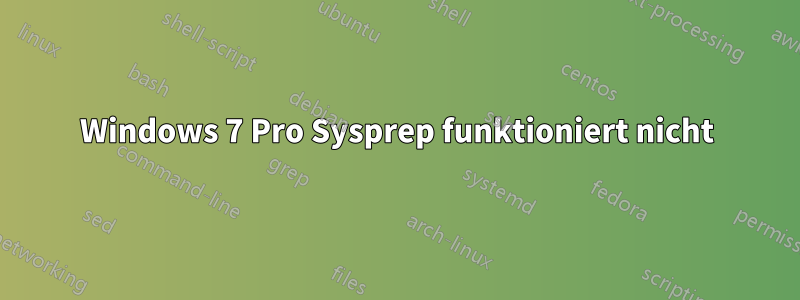
Ich versuche, eine Windows 7 Professional-Maschine per Sysprep vorzubereiten, bevor ich ein Image für die Massenbereitstellung auf identischer Hardware erstelle, und habe große Schwierigkeiten, Sysprep (überhaupt) zum Laufen zu bringen.
Ich habe mit WSIM eine XML-Antwortdatei erstellt und verfüge über eine grundlegende Datei „setupcomplete.cmd“, aber keine der Konfigurationen in der Antwortdatei scheint angewendet zu werden.
Ich habe Technet-Artikel gelesen und gegoogelt, aber ich habe immer noch keine Ahnung, warum das passiert. Kann sich jemand die Antwortdatei ansehen, die ich angehängt habe, und mir sagen, was ich falsch mache?
Danke, Callum
AutoUnattend.XML
<?xml version="1.0" encoding="utf-8"?>
<unattend xmlns="urn:schemas-microsoft-com:unattend">
<settings pass="specialize">
<component name="Microsoft-Windows-Shell-Setup" processorArchitecture="x86" publicKeyToken="31bf3856ad364e35" language="neutral" versionScope="nonSxS" xmlns:wcm="http://schemas.microsoft.com/WMIConfig/2002/State" xmlns:xsi="http://www.w3.org/2001/XMLSchema-instance">
<AutoLogon>
<Password>
<Value>**********************************</Value>
<PlainText>false</PlainText>
</Password>
<Username>administrator</Username>
<LogonCount>1</LogonCount>
<Enabled>true</Enabled>
</AutoLogon>
<WindowsFeatures>
<ShowMediaCenter>false</ShowMediaCenter>
<ShowWindowsMediaPlayer>false</ShowWindowsMediaPlayer>
</WindowsFeatures>
<CopyProfile>true</CopyProfile>
<DoNotCleanTaskBar>true</DoNotCleanTaskBar>
<RegisteredOrganization>SomeCompany (UK) Ltd.</RegisteredOrganization>
<RegisteredOwner>SomeCompany User</RegisteredOwner>
<ShowWindowsLive>false</ShowWindowsLive>
<TimeZone>GMT Standard Time</TimeZone>
</component>
<component name="Security-Malware-Windows-Defender" processorArchitecture="x86" publicKeyToken="31bf3856ad364e35" language="neutral" versionScope="nonSxS" xmlns:wcm="http://schemas.microsoft.com/WMIConfig/2002/State" xmlns:xsi="http://www.w3.org/2001/XMLSchema-instance">
<DisableAntiSpyware>true</DisableAntiSpyware>
</component>
</settings>
<settings pass="oobeSystem">
<component name="Microsoft-Windows-International-Core" processorArchitecture="x86" publicKeyToken="31bf3856ad364e35" language="neutral" versionScope="nonSxS" xmlns:wcm="http://schemas.microsoft.com/WMIConfig/2002/State" xmlns:xsi="http://www.w3.org/2001/XMLSchema-instance">
<SystemLocale>en-UK</SystemLocale>
<UserLocale>en-UK</UserLocale>
<UILanguage>en-US</UILanguage>
<InputLocale>0809:00000809</InputLocale>
</component>
<component name="Microsoft-Windows-Shell-Setup" processorArchitecture="x86" publicKeyToken="31bf3856ad364e35" language="neutral" versionScope="nonSxS" xmlns:wcm="http://schemas.microsoft.com/WMIConfig/2002/State" xmlns:xsi="http://www.w3.org/2001/XMLSchema-instance">
<OOBE>
<HideEULAPage>true</HideEULAPage>
<HideWirelessSetupInOOBE>true</HideWirelessSetupInOOBE>
<NetworkLocation>Work</NetworkLocation>
<ProtectYourPC>1</ProtectYourPC>
</OOBE>
<UserAccounts>
<AdministratorPassword>
<Value>*************************************************=</Value>
<PlainText>false</PlainText>
</AdministratorPassword>
</UserAccounts>
</component>
<component name="Microsoft-Windows-Deployment" processorArchitecture="x86" publicKeyToken="31bf3856ad364e35" language="neutral" versionScope="nonSxS" xmlns:wcm="http://schemas.microsoft.com/WMIConfig/2002/State" xmlns:xsi="http://www.w3.org/2001/XMLSchema-instance">
<Reseal>
<Mode>OOBE</Mode>
</Reseal>
</component>
</settings>
<settings pass="generalize">
<component name="Microsoft-Windows-Security-SPP" processorArchitecture="x86" publicKeyToken="31bf3856ad364e35" language="neutral" versionScope="nonSxS" xmlns:wcm="http://schemas.microsoft.com/WMIConfig/2002/State" xmlns:xsi="http://www.w3.org/2001/XMLSchema-instance">
<SkipRearm>0</SkipRearm>
</component>
</settings>
<settings pass="windowsPE">
<component name="Microsoft-Windows-Setup" processorArchitecture="x86" publicKeyToken="31bf3856ad364e35" language="neutral" versionScope="nonSxS" xmlns:wcm="http://schemas.microsoft.com/WMIConfig/2002/State" xmlns:xsi="http://www.w3.org/2001/XMLSchema-instance">
<UseConfigurationSet>true</UseConfigurationSet>
</component>
</settings>
<cpi:offlineImage cpi:source="wim:c:/wim/install.wim#Windows 7 PROFESSIONAL" xmlns:cpi="urn:schemas-microsoft-com:cpi" />
</unattend>
Antwort1
Und die Antwort besteht darin, nicht die von HP bereitgestellte Standardinstallation von Windows 7 zu verwenden. Die vorherigen Sysprep-Versuche von HP werden nicht ordnungsgemäß bereinigt bzw. gelöscht und wirken sich nachteilig auf Ihre Sysprep-Versuche aus.
CD
Antwort2
Ich habe stundenlang versucht, dieses Problem zu lösen, und habe endlich die Lösung gefunden.
Mein konkretes Problem bestand darin, dass die Komponenten in den OOBE-Einstellungen des Windows Shell-Setups nicht richtig angewendet wurden.
Dabei handelt es sich um Einstellungen, die die unbeaufsichtigte Installation der Windows-Willkommensseite betreffen und Einstellungen wie „EULA-Seite ausblenden“, „Netzwerkstandort einrichten“ und „PC schützen“ umfassen.
Meine unattend.xml-Datei wurde mit WSIM unter Verwendung eines 32-Bit-Windows-Image erstellt, als ich Sysprep auf einem 64-Bit-Computer anwendete, was dazu führte, dass die Komponenten ignoriert wurden.


